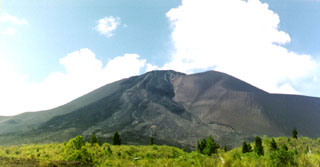Report on Soputan (Indonesia) — October 2003
Bulletin of the Global Volcanism Network, vol. 28, no. 10 (October 2003)
Managing Editor: Edward Venzke.
Soputan (Indonesia) Ash explosion and lava flows on 31 August
Please cite this report as:
Global Volcanism Program, 2003. Report on Soputan (Indonesia) (Venzke, E., ed.). Bulletin of the Global Volcanism Network, 28:10. Smithsonian Institution. https://doi.org/10.5479/si.GVP.BGVN200310-266030
Soputan
Indonesia
1.112°N, 124.737°E; summit elev. 1785 m
All times are local (unless otherwise noted)
Increased activity during 18-22 July 2003 at Soputan consisted of frequent ash explosions and large glowing lava avalanches (BGVN 28:08). Seismicity from August through mid-October was dominated by avalanche events, with a few tectonic earthquakes (table 4). White gas emissions in this period were commonly seen rising 25-50 m above the crater, but were also reported as high as 1,000 m in late August and September. On 31 August there was ash explosion accompanied by ejection of incandescent material. The ash column reached 1,000 m above the summit. Lava flowed 750 m down the SW slope, and some descended to the N. Volcanic tremor that week (18-31 August) had an amplitude of 10-38 mm. The hazard status remained at Alert Level 2 (on a scale of 1-4) through 19 October.
Table 4. Seismicity at Soputan, 18 August-19 October 2003. Courtesy of VSI.
| Date | Avalanche Earthquakes | Tectonic Earthquakes |
| 18 Aug-31 Aug 2003 | 71 | -- |
| 29 Sep-05 Oct 2003 | 80 | 12 |
| 06 Oct-12 Oct 2003 | 30 | 8 |
| 13 Oct-19 Oct 2003 | 62 | 9 |
Geological Summary. The Soputan stratovolcano on the southern rim of the Quaternary Tondano caldera on the northern arm of Sulawesi Island is one of Sulawesi's most active volcanoes. The youthful, largely unvegetated volcano is the only active cone in the Sempu-Soputan volcanic complex, which includes the Soputan caldera, Rindengan, and Manimporok (3.5 km ESE). Kawah Masem maar was formed in the W part of the caldera and contains a crater lake; sulfur has been extracted from fumarolic areas in the maar since 1938. Recent eruptions have originated at both the summit crater and Aeseput, a prominent NE-flank vent that formed in 1906 and was the source of intermittent major lava flows until 1924.
Information Contacts: Dali Ahmad, Hetty Triastuty, Nia Haerani, and Suswati, Volcanological Survey of Indonesia (VSI), Jalan Diponegoro No. 57, Bandung 40122, Indonesia (URL: http://www.vsi.esdm.go.id/).

